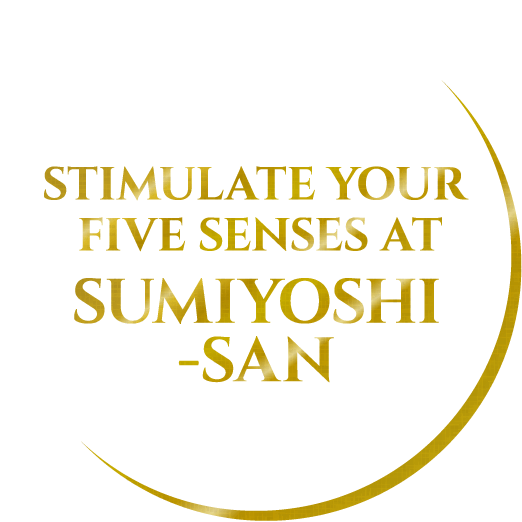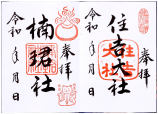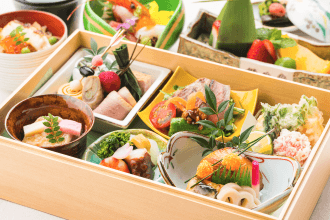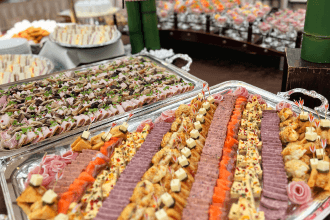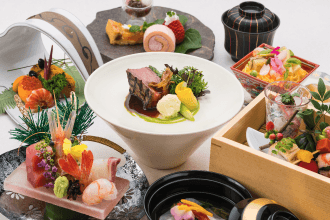Taste the finest Japanese cuisine and
experience traditional culture and entertainment.
Feel the breath of history with a visit
to Sumiyoshi Taisha Shrine guided by a priest.
Please languish an unforgettable moment at Sumiyoshi-san Shrine.
-
Taste
We are particular about "dashi" (soup stock), the source of Japanese cuisine, and pursue the original taste of ingredients using cooking methods and techniques handed down from ancient times.
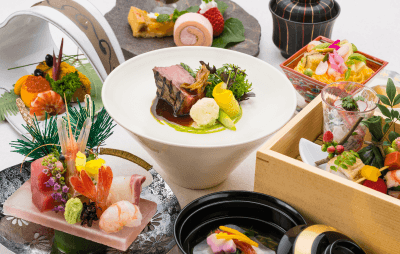
This is an illustrative example of the cuisine. Enjoy a variety of Japanese dishes prepared by chefs who have studied in first-class kitchens. -
See
Visitors can enjoy traditional performing arts such as Sumiyoshi Odori dance, which originated from Empress Jingu's expedition to Silla, as well as koto, and noh.
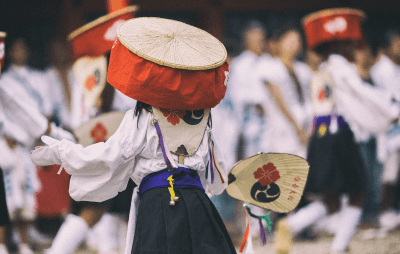
A scene from the Sumiyoshi Odori dance. Dressed in unique costumes, the Kyodo‘shi (dance master) leads the dance, chants while tapping the handle of the umbrella in the center and moving to the beat, and the little girls dance around as if writing the character for "heart" while beating their fans. -
Know
In addition to the main shrine, which is a national treasure, and the famous symbolic Sorihashi Bridge, priests will guide you through the history scattered throughout the shrine grounds with explanations.
By learning deeply about the history and culture of Sumiyoshi Taisha Shrine, you will enjoy an intense time that cannot be experienced during a free visit.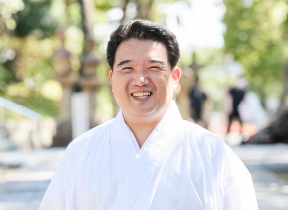
A priest who actually serves Sumiyoshi Taisha Shrine will guide you through the grounds.
Overview and History
Sumiyoshi Taisha is one of Japan’s most ancient Shinto shrines. According to traditional Japanese chronicles, the shrine was established in 211 by the legendary empress-regent Jingū, who governed western Honshu after her husband’s death. Empress Jingū dedicated the shrine to three deities of the sea, who are collectively called the Sumiyoshi Sanjin. In Shinto mythology, the Sanjin came into being when the deity Izanagi, co-creator of the Japanese archipelago, purified himself in the sea after a voyage to the underworld. One theory holds that the deities are the three bright stars of Orion’s belt, which were commonly used in navigation. After Empress Jingū died, she was enshrined alongside the Sanjin at Sumiyoshi Taisha as a deity in her own right.
read more
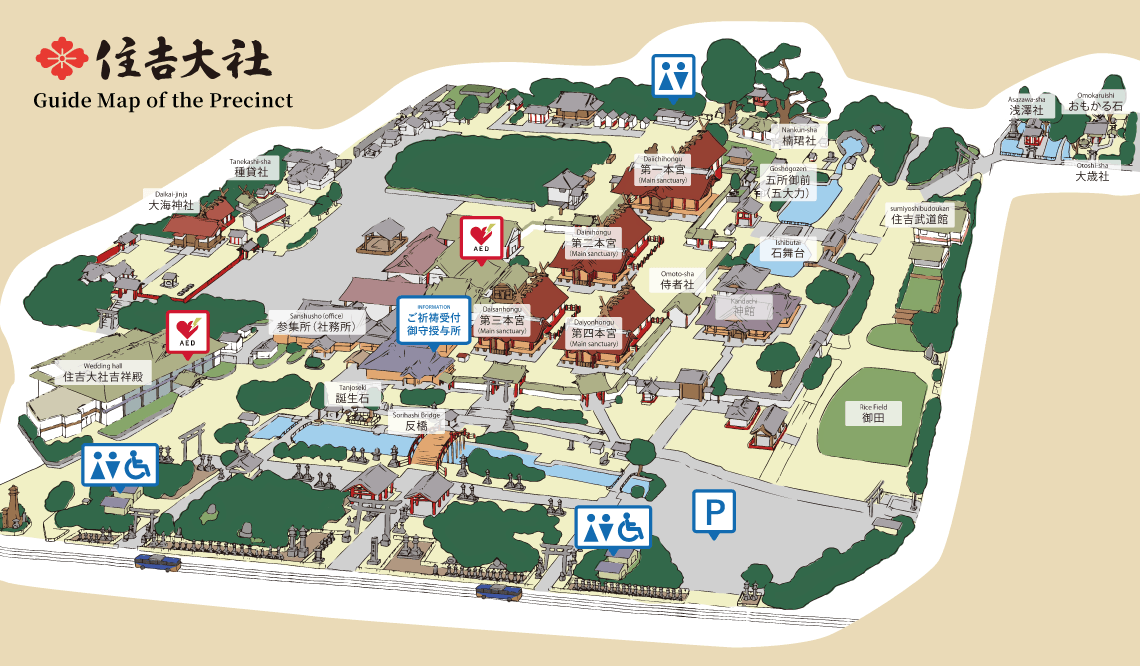
-

Daiichi Hongū
Daiichi Hongū, or “first main shrine,” is dedicated to Sokotsutsuno-o no Mikoto, one of the three maritime deities enshrined at Sumiyoshi Taisha. Its offering hall, or heiden, is larger than those of the other three main shrines.
read more
-

Sorihashi Bridge (Taikobashi)
Although there are records of a bridge here since the thirteenth century, the bridge in its current form was built around 1600 with funds donated by Yododono (1567–1615). Yododono was a consort of Toyotomi Hideyoshi (1536–1598), the warlord who ruled Japan from 1582 to 1598.
read more
-
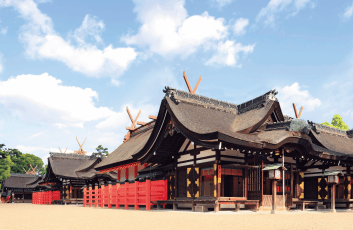
Sumiyoshi-zukuri
The four main sanctuary buildings, or honden, of Sumiyoshi Taisha are archetypal examples of the sumiyoshi-zukuri architectural style. Sumiyoshi-zukuri is noteworthy because it pre-dates the arrival of Buddhists to Japan, who brought with them architectural techniques and styles from the Asian mainland in the sixth century. Most other religious structures in Japan were built (or rebuilt) with the later, imported styles.
read more
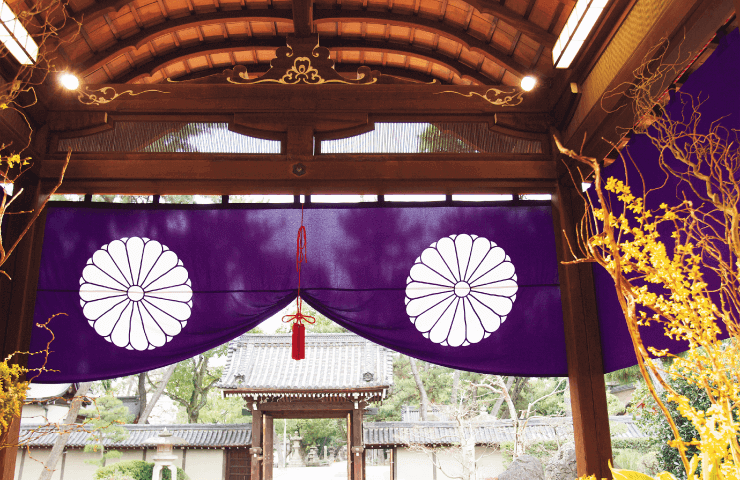
Overview and History
Sumiyoshi Taisha is one of Japan’s most ancient Shinto shrines. According to traditional Japanese chronicles, the shrine was established in 211 by the legendary empress-regent Jingū, who governed western Honshu after her husband’s death. Empress Jingū dedicated the shrine to three deities of the sea, who are collectively called the Sumiyoshi Sanjin. In Shinto mythology, the Sanjin came into being when the deity Izanagi, co-creator of the Japanese archipelago, purified himself in the sea after a voyage to the underworld. One theory holds that the deities are the three bright stars of Orion’s belt, which were commonly used in navigation. After Empress Jingū died, she was enshrined alongside the Sanjin at Sumiyoshi Taisha as a deity in her own right.
Sumiyoshi Taisha was built within a few meters of Osaka Bay, but natural silt buildup and land reclamation projects have moved the shoreline almost 7 kilometers to the west. Between the seventh and ninth centuries, the nearby port of Naniwa was the departure point for trade and diplomatic missions to China. Naniwa was also the beginning and end point of the domestic trade route that connected Osaka to northern Japan.
Sumiyoshi Taisha’s main shrines—the four halls which house its patron deities—face west toward the bay. This sets them apart from most Shinto shrines, which face south or east in accordance with geomancy rules adopted from China during the Nara period (710–794). In the past, the main shrines were rebuilt every 20 years, but this practice was disrupted by civil war in the sixteenth century and ceased entirely in the early nineteenth.
“Sumiyossan,” as Osaka residents affectionately call the shrine, appears in many Japanese stories, from ancient folktales and the eleventh-century Tale of Genji to more recent literary works. A memorial on the shrine grounds honors Kawabata Yasunari (1899–1972), the Nobel Prize–winning author who set his short story “Sorihashi” (1948) at the shrine’s iconic bridge.
For over 1,800 years, the shrine has protected the maritime gateway to Osaka and the old capitals of Nara and Kyoto beyond. Its devotees have included monarchs and poets, seafarers and traders, along with millions of others from all walks of life. Each January, two million people come to Sumiyoshi Taisha for hatsumōde, the traditional first shrine visit of the year. The midsummer Sumiyoshi Matsuri is one of Osaka’s biggest festivals, featuring a parade of portable shrines. Other events, such as ritual rice planting in June and a moon-viewing celebration in early autumn, draw crowds with music, dancing, and readings of traditional Japanese poetry.
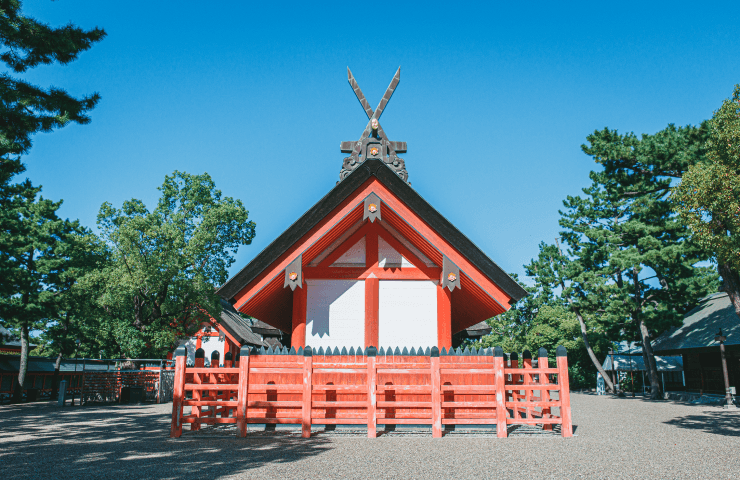
Daiichi Hongū
Daiichi Hongū, or “first main shrine,” is dedicated to Sokotsutsuno-o no Mikoto, one of the three maritime deities enshrined at Sumiyoshi Taisha. Its offering hall, or heiden, is larger than those of the other three main shrines. This difference in size, however, does not reflect any difference in status between the deities. They are considered equals, and the four main shrines are otherwise identical.
Coins lodged in the shingles at the edge of the hall’s roof are errant offerings tossed by the crowds that gather at the shrine during the New Year holidays. The current honden (main sanctuary) was built in 1810 and is designated a National Treasure.
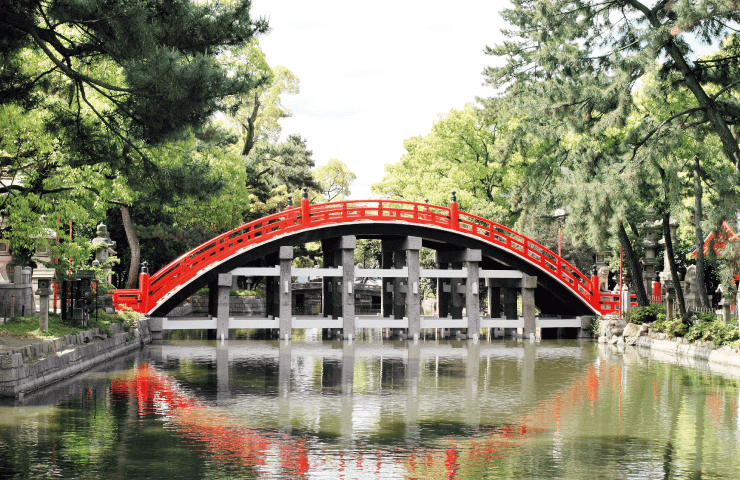
Sorihashi Bridge
The official name of this steeply curved bridge is Sorihashi, or “arched bridge,” but the structure is often called Taikobashi, or “drum bridge,” after the shape created by its reflection in the water below. According to popular tradition, crossing the bridge is an act of spiritual purification.
The shape of the bridge may have been inspired by rainbows, which connect the earth to the heavens. In Shinto mythology, the deities Izanagi and Izanami created the Japanese archipelago by stirring the sea with a rod while standing on a floating rainbow bridge. Izanagi is the “father” of Sumiyoshi Taisha’s patron deities: they came into being when he purified himself in the sea after a voyage to the underworld.
Although there are records of a bridge here since the thirteenth century, the bridge in its current form was built around 1600 with funds donated by Yododono (1567–1615). Yododono was a consort of Toyotomi Hideyoshi (1536–1598), the powerful warlord who re-unified Japan after a period of civil war and ruled from 1582 to 1598. Yododono was seeking the gods’ favor for her son Toyotomi Hideyori (1593–1615), who was at war with Tokugawa Ieyasu (1543–1616), founder of the Tokugawa shogunate (1603–1868).
The first arched bridge is believed to have been constructed by shipwrights, and shipbuilders have played a leading role in maintaining the structure ever since. It has been rebuilt and repaired numerous times. Before the steps were added in 1955, the only footholds were the gaps between the wooden slats, open to the water.
The modern bridge has a steel frame and cypress-wood boards. It is approximately 21 meters long, 5 meters tall, and 6 meters wide, with a slope of more than 40 degrees at its steepest point. The metalwork on the bridge’s railings has been preserved since the Edo period (1603–1867).
Nobel Prize–winning author Kawabata Yasunari (1899–1972) made the bridge famous in his short story that bears its name. “Sorihashi” is narrated by a man recalling a childhood incident in which his mother revealed a painful secret to him at the top of the bridge. The narrator tells the reader that descending the slope on the far side with his illusions shattered was more frightening than the initial climb.

Sumiyoshi-zukuri
The four main sanctuary buildings, or honden, of Sumiyoshi Taisha are archetypal examples of the sumiyoshi-zukuri architectural style. Sumiyoshi-zukuri is noteworthy because it pre-dates the arrival of Buddhists to Japan, who brought with them architectural techniques and styles from the Asian mainland in the sixth century. Most other religious structures in Japan were built (or rebuilt) with the later, imported styles.
Sumiyoshi-zukuri buildings are similar to the temporary structures created for the daijōsai, a Shinto ceremony performed to mark the accession of a new emperor. The style is thought to have roots in ancient palace architecture, and is defined by the features of the hall, dimensions, entrance, roof decoration, and other features of the building. The buildings have simple gable roofs with pairs of crossed ornamental beams at each end. The entrance is in one of the gable walls and, unlike at many shrines and temples, there is no veranda. The buildings lack the central “sacred pillar” to hold up the roof that is a feature common to Shinto shrines built in other styles. The interior is divided into two spaces: an outer sanctuary that is accessed by priests and an inner sanctuary reserved for the deity. Each honden is surrounded by a wooden fence that separates the sacred area from the outside world.
In the past, Sumiyoshi Taisha’s four main shrines were dismantled and rebuilt every 20 years. This practice was interrupted by civil war of the sixteenth century and abandoned entirely in the early nineteenth century. The current honden date to 1810 and are designated National Treasures.
PLAN
-
01
和nagomi
This plan is centered around a meal at the prestigious Kisshoden, with the option to enjoy traditional performing arts such as Japanese harp koto.
-
02
雅miyabi
This plan includes a meal in Shinkan, a historical building not normally accessible by the public, and optional traditional entertainment such as koto.
和nagomi
This plan is centered around a meal at the prestigious Kisshoden, with the option to enjoy traditional performing arts such as Japanese harp koto.
(the shrine visit method differs depending on the time of day).
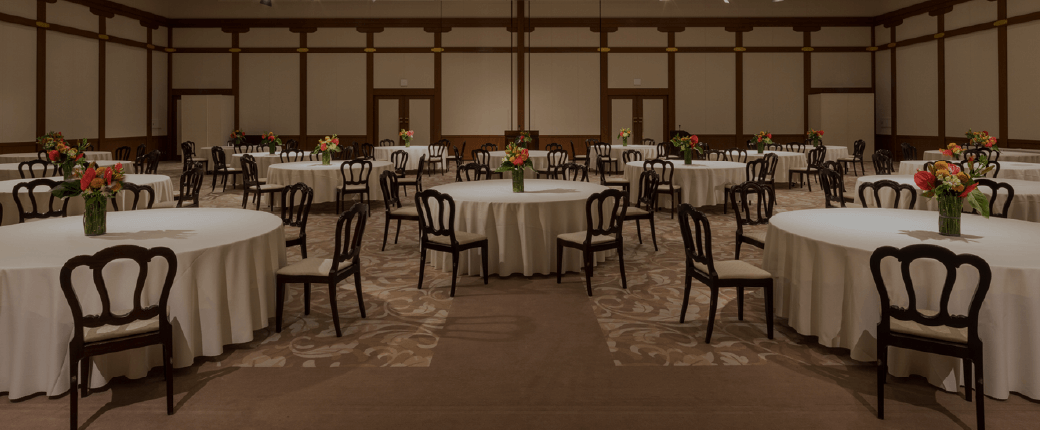
A sense of quality that is unique to Sumiyoshi Taisha,
even for a peaceful dinner.
A banquet that resonates with each and every guest.
Formal shrine visit
(with guidance by a priest)
Hours: 10 am to 4 pm
Formal shrine visit
(with guidance around the grounds by a priest)Dinner at KisshodenViewing (optional)
Group prayers are offered for the prosperity of company fortune, business, and victory.
The priest will recite a prayer and the representative of the group will offer a tamagushi (jewel skewer.)
Flow of shrine visit
- Arrive at the south parking lot
- Formal shrine visit
- Guided tour of shrine grounds
by a priest
-
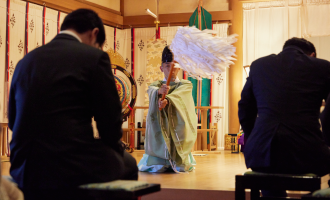
Prayers. -
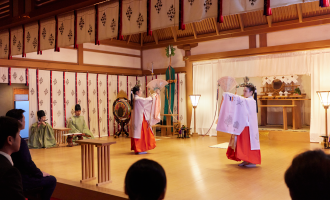
kagurame perform the traditional dance of Sumiyoshi Taisha Shrine in front of the shrine. -
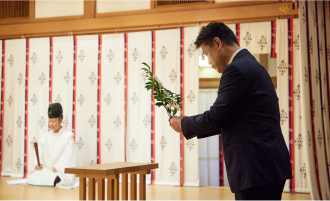
The representative of the group is asked to offer a tamagushi (sacred skewer). -
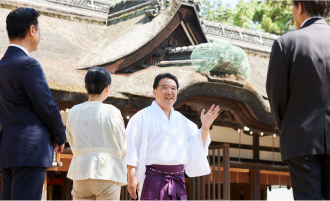
The priest will guide guests around the shrine grounds with commentary.
Time Schedule for the Day
-
Arrival and Registration
Upon arrival, we will confirm the number of guests in your group. If you wish to receive an official shrine seal (for a fee), we will take your seal book at this time.
*Hours: 10 am to 4 pm -
Shrine visit and prayerapprox.90min.
A group prayer will be held. Afterwards, a priest will guide guests to the historic sites within the shrine grounds while giving commentary.
-
Meal/Viewing (optional)approx.120min.
Enjoy dining at Kisshoden. After your meal, enjoy Sumiyoshi-san all the way through with optional traditional entertainment and reserved souvenirs.
-
Finish
Sumiyoshi Mugon Mairi
-Special night-time shrine visit-
Period: Early October to Mid-December
Hours: 5 pm to 6:30 pm
Special night-time shrine visit and prayerDinner at KisshodenViewing(optional)
This is a special plan whereby visitors can enter the shrine grounds after-hours. You will be shown around the main shrine by Kagurame (shrine maiden). Please savor the atmosphere of Sumiyoshi Taisha after dark, an experience not possible on a regular visit.
Flow of shrine visit
- Arrive at the south parking lot
- Shown inside the grounds
by Kagurame - Purification ceremony in front of Daiichihongu
(1st Main Sanctuary)
-
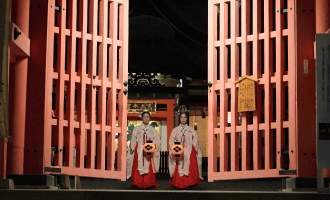
Kagurame will greet you at the main gate, where your special night-time tour will begin. -
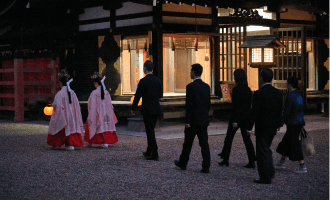
Kagurame will lead you to Daiichihongu (1st Main Sanctuary) -
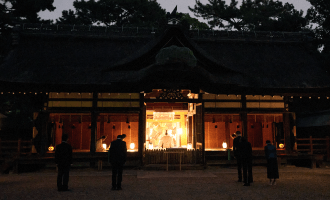
A prayer will be offered in front of the main shrine (may take place inside during rainy weather). -
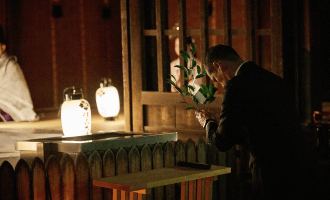
The representative of the group will be asked to offer a tamagushi (sacred skewer).
Time Schedule for the Day
-
Arrival and Registrationapprox.15min.
If there are multiple buses, the tour will begin once all buses have arrived.
*Hours: 5 pm to 6:30 pm -
Shrine visit and prayerapprox.30min.
Kagurame will lead you to Daiichihongu (1st Main Sanctuary). A prayer will be made in front of the main shrine.
*This is a special prayer, so we ask that you please refrain from conversation completely. -
Meal/Viewing (optional)approx.120min.
Enjoy dining at Kisshoden. After your meal, enjoy Sumiyoshi-san all the way through with optional traditional entertainment and reserved souvenirs.
-
Finish
Meals
Choose from various dining options, including a colorful Irodori bento box lunch, Kaiseki (traditional multi-course Japanese dinner), or buffet. The menu changes according to the season with a focus on seasonal vegetables.
Please Note
- We ask that you choose one of the following dining options: Irodori bento, Kaiseki, or buffet.
- The menu changes according to the season.
- Reservations require a minimum of 20 people.
Price
For guests who choose either Irodori bento or buffet
Price per person for a party of 20 people
9,760yen
(including tax and service charge)
9,760 yen × 20persons = 195,200 yen
(including tax and service charge)
- Price does not include beverages.
- Available dishes differ throughout the seasons.
- Price is for parties of 20 people only.
- Reservations require a minimum of 20 people.
- For parties of more than 20 people, an additional 6,050 yen will be required per person.
- The venue fee varies for parties of 50 people or more, so please contact us for details.
- We cater to up to 250 guests.
- Please note that there are some days when this offer is not available. (Excluded days: Dec. 24-Jan. 31, Wednesdays when the restaurant is closed, and shrine ritual and ceremony days)
- Please make a reservation at least 30 days in advance.
Guests who choose Kaiseki
−KOTO Course−
Price per person for a party of 20 people
13,390yen
(including tax and service charge)
13,390 yen × 20persons = 267,800 yen
(including tax and service charge)
- Price does not include beverages.
- Available dishes differ throughout the seasons.
- Price is for parties of 20 people only.
- Please contact us for parties of 5 to 19 people.
- For parties of more than 20 people, an additional 9,680 yen will be required per person.
- The venue fee varies for parties of 50 people or more, so please contact us for details.
- We cater to up to 250 guests.
- Please note that there are some days when this offer is not available. (Excluded days: Dec. 24-Jan. 31, Wednesdays when the restaurant is closed, and shrine ritual and ceremony days)
- Please make a reservation at least 30 days in advance.
- The HANA Course is also available. Please contact us for details.
雅miyabi
This plan includes a meal in Shinkan, a historical building not normally accessible by the public, and optional traditional entertainment such as koto.
(the shrine visit method differs depending on the time of day).
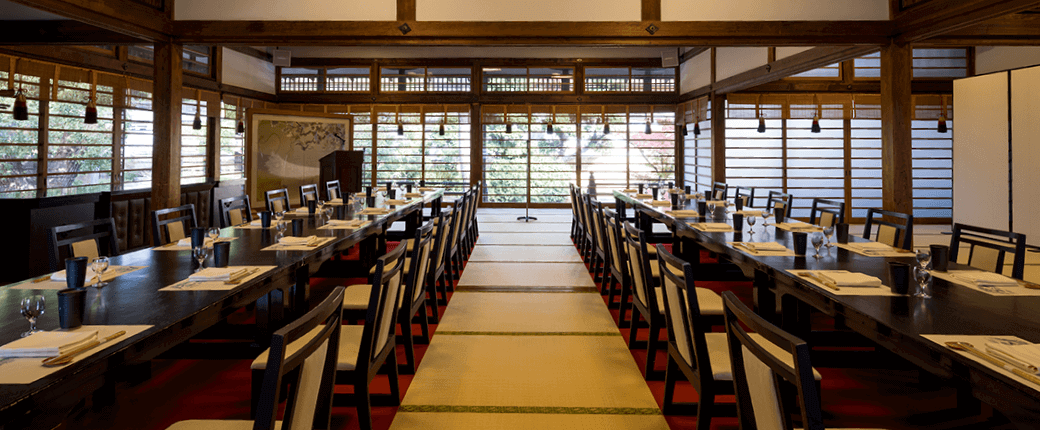
Enjoy the best hospitality in this special guest house designated as a registered tangible cultural property.
Formal shrine visit
(with guidance by a priest)
Hours: 10 am to 4 pm
Formal shrine visit
(with guidance around the grounds by a priest)Dinner at ShinkanViewing (optional)
Group prayers are offered for the prosperity of company fortune, business, and victory.
The priest will recite a prayer and the representative of the group will offer a tamagushi (jewel skewer.)
Flow of shrine visit
- Arrive at the south parking lot
- Formal shrine visit
- Guided tour of shrine grounds
by a priest
-

Prayers. -

kagurame perform the traditional dance of Sumiyoshi Taisha Shrine in front of the shrine. -

The representative of the group is asked to offer a tamagushi (sacred skewer). -

The priest will guide guests around the shrine grounds with commentary.
Time Schedule for the Day
-
Arrival and Registration
Upon arrival, we will confirm the number of guests in your group. If you wish to receive an official shrine seal (for a fee), we will take your seal book at this time.
*Hours: 10 am to 4 pm -
Shrine visit and prayerapprox.90min.
A group prayer will be held. Afterwards, a priest will guide guests to the historic sites within the shrine grounds while giving commentary.
-
Meal/Viewing (optional)approx.120min.
Enjoy dining at Shinkan. After your meal, enjoy Sumiyoshi-san all the way through with optional traditional entertainment and reserved souvenirs.
-
Finish
Sumiyoshi Mugon Mairi
-Special night-time shrine visit-
Period: Early October to Mid-December
Hours: 5 pm to 6:30 pm
Special night-time shrine visit and prayerDinner at ShinkanViewing(optional)
This is a special plan whereby visitors can enter the shrine grounds after-hours. You will be shown around the main shrine by Kagurame (shrine maiden). Please savor the atmosphere of Sumiyoshi Taisha after dark, an experience not possible on a regular visit.
Flow of shrine visit
- Arrive at the south parking lot
- Shown inside the grounds
by Kagurame - Purification ceremony in front of Daiichihongu
(1st Main Sanctuary)
-

Kagurame will greet you at the main gate, where your special night-time tour will begin. -

Kagurame will lead you to Daiichihongu (1st Main Sanctuary) -

A prayer will be offered in front of the main shrine (may take place inside during rainy weather). -

The representative of the group will be asked to offer a tamagushi (sacred skewer).
Time Schedule for the Day
-
Arrival and Registrationapprox.15min.
If there are multiple buses, the tour will begin once all buses have arrived.
*Hours: 5 pm to 6:30 pm -
Shrine visit and prayerapprox.30min.
Kagurame will lead you to Daiichihongu (1st Main Sanctuary). A prayer will be made in front of the main shrine.
*This is a special prayer, so we ask that you please refrain from conversation completely. -
Meal/Viewing (optional)approx.120min.
Enjoy dining at Shinkan. After your meal, enjoy Sumiyoshi-san all the way through with optional traditional entertainment and reserved souvenirs.
-
Finish
Meals
This is a course menu of Japanese cuisine. We serve seasonal colorful dishes made with our special soup stock offering the kind of sincerity that only Japanese cuisine can.
Menu (Example)
Kaiseki
-
Festive hors d'oeuvres
Soaked Osaka shirona and deep-fried tofu Tofu paste with chestnuts and persimmon, simmered Katsuma Pumpkin Baked cod roe with saikyo sauce, Satsumaimo-mitsuni (Japanese sweet potato simmered in honey), edible chrysanthemum “Mottenohoka”
-
Suimono (clear soup)
Soup topped with sliced raw tuna Torikai eggplant, Tennoji turnip, seasonal chrysanthemum, yuzu
-
Sliced raw fish
Sashimi of tuna, sashimi of sea bream, prawn, garnishes
-
Fish dishes
Roasted salmon with roasted egg Red clay Daikoku shimeji mushroom Kosode style conger eel sushi Grilled Tanabe daikon dengaku Hajikami (Pickled ginger sprout)
-
Meat dishes
Nose Kuroushi beef tender stew, Ragu sauce, grilled vegetables, watercress
-
Meal, pickles, Tomewan (last soup)
Rice cooked with matsutake mushrooms and taro stem Pickled takana, butterbur, small Ume plum Red miso soup, powdered sansho (Japanese pepper)
-
Dessert
Mont Blanc, pear, persimmon, mint
-
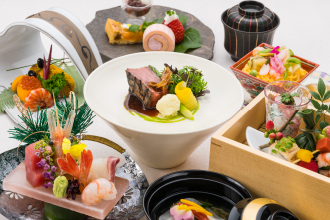
Primarily featuring numerous uniquely Japanese dishes by chefs who have meticulously refined their skills in the kitchens of top-tier restaurants, this dining option allows you to enjoy the distinct flavors of each season, like only Japanese cuisine can.
*Featured dishes and dinnerware are for illustrative purposes only. -
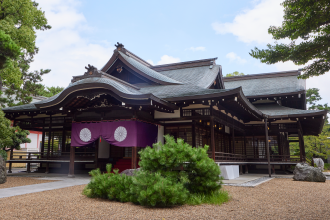
Usually strictly closed and never open to the public, the Shinkan is a historical building erected to commemorate the accession to the throne of Emperor Taisho.
Price
Price per person for 20 persons
17,625yen
(including tax and service charge)
17,625 yen × 20 persons = 352,500 yen (including tax and service charge)
- Price does not include beverages.
- Available dishes differ throughout the seasons.
- Price is for parties of 20 people only.
- Reservations require a minimum of 20 people.
- For parties of more than 20 people, an additional 12,100 yen will be required per person.
- We cater to up to 50 guests.
- Please note that there are some days when this offer is not available.
(Excluded days: Dec. 24-Jan. 31, Wednesdays when the restaurant is closed, and shrine ritual and ceremony days) - Please make a reservation at least 30 days in advance.
Option
-
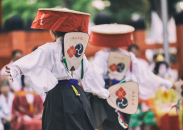
Sumiyoshi dance
-
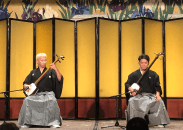
Shamisen
-
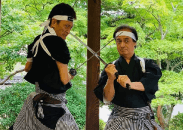
Ninja/Samurai
-
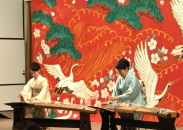
Koto
-
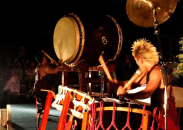
Taiko
*We can make arrangements according to your needs and budget. Please contact us for details.
SOUVENIR
Souvenirs reserved in advance can be collected at Kisshoden. Please feel free to contact us.
-
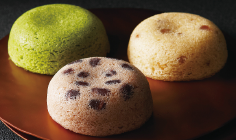
Fukujudo-HidenobuFukufukufu
Established in 1948 Japanese pudding made with our original method of kneading sweet red bean paste into a dough blended with rice flour and steaming it.
1,296 yen for a pack of 5
(including tax and service charge)2,592 yen for a pack of 10
(including tax and service charge)Shelf life: 10 days from the date of manufacture
*Also available in packs of 15 and 20. -
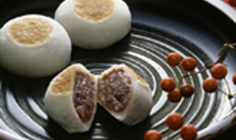
Sumiyoshi Ka’an KikujuAkamaedare
Established in 1952 A baked rice cake with sweet red bean paste, named after the akamaedare (red apron) used by the girls of teahouses who took respite during pilgrimages to Sumiyoshi Taisha Shrine in the olden days.
1,804 yen for a pack of 10
(including tax and service charge)2,668 yen for a pack of 15
(including tax and service charge)Shelf life: 2 days from the date of manufacture
*Also available in packs of 20. -
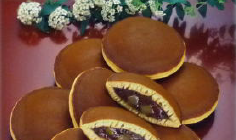
Sumiyoshi Ka’an KikujuDorayaki
Established in 1952 Kikuju's signature large red beans and chestnuts combine to create a simple taste.
1,426 yen for a pack of 5
(including tax and service charge)Shelf life: 3 days from the date of manufacture
*10 pack, 15 pack, and 24 pack are available -

Suehirodo - Sumiyoshi's
specialtySatsumayakiEstablished in the first year of Meiji era The homemade red bean paste made from Tokachi azuki beans is wrapped in a secret recipe skin and baked on a bamboo skewer.
5 pieces 1,004 yen
(including tax and service charge)10 pieces 2,160 yen
(including tax and service charge)Shelf life: 4 days from the date of manufacture
VOICE
-
It was a very meaningful time for me to recognize this spot that I would normally simply walk straight by as in fact possessing such significance and history.
Female, 30's
-
I was impressed by the depth of knowledge of the priests. I would like to hear more about it Kisshoden if I have the chance. Not only was the food delicious, but each dish had its own story to tell.
Female, 40s
-
The legitimacy and characteristics of Sumiyoshi Taisha were conveyed to us in a straightforward and fun way, which tickled our intellectual curiosity. I knew of Naniwa vegetables, but it was very satisfying to actually taste them this time.
Male, 40s
-
I could really tell that each dish was made with meticulous care. They were all so full of flavor and delight.
Female, 30's
-
I enjoyed not only the historical background of Sumiyoshi Taisha but also the food, culture, etc. from a different point of view to the other shrines I have visited in the past.
Male, 50’s
FLOW FROM APPLICATION
TO THE DAY OF VISIT
-
Application
Email / Phone
Please select your dining venue and theater performance options at least 30 days in advance.
Please note that there are some days when this offer is not available. (Excluded days: Dec. 24-Jan. 31, Wednesdays when the restaurant is closed, and shrine ritual and ceremony days) -
3 weeks prior
Direct visit / E-mail / Phone call
We will discuss the formal visit, number of people, meal table plan, and other details of the day.
-
3 days before
Deadline for changes
3 days prior to the reservation deadline for changes in the number of people, etc.
-
Day of visit
Please spend a special time at Sumiyoshi-san.
ACCESS
2-9-89 Sumiyoshi, Sumiyoshi-ku,
Osaka 558-0045
APPLICATION AND INQUIRIES
-
From the Internet
Please fill out the required information in the e-mail form and press the send button.
-
Phone
Please feel free to call us.
10:00 - 18:00 (Closed on Wednesdays)
